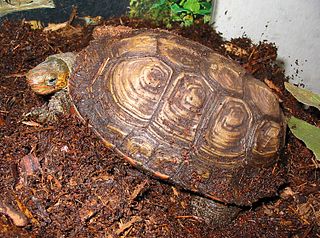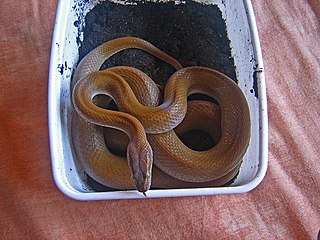
Agamidae is a family of over 550 species of iguanian lizards indigenous to Africa, Asia, Australia, and a few in Southern Europe. Many species are commonly called dragons or dragon lizards.

Calotes is a genus of lizards in the draconine clade of the family Agamidae. The genus contains 29 species. Some species are known as forest lizards, others as "bloodsuckers" due to their red heads, and yet others as garden lizards. The genus name Calotes has been derived from the Greek word Καλότης (Kalótës), meaning ‘beauty’, referring to the beautiful pattern of this genus.

Draco is a genus of agamid lizards that are also known as flying lizards, flying dragons or gliding lizards. These lizards are capable of gliding flight via membranes that may be extended to create wings (patagia), formed by an enlarged set of ribs. They are arboreal insectivores.

Gonocephalus is a genus of agamid lizards endemic to southeast Asia.

Harpesaurus is a genus of lizards in the family Agamidae. The genus is endemic to Indonesia.
Hypsilurus is a genus of arboreal lizards in the family Agamidae. The genus is endemic to Melanesia.

The genus Sphenomorphus – vernacularly also known as the common skinks – currently serves as a "wastebin taxon" for numerous skinks. While most or all species presently placed here are probably rather close relatives, the genus as presently delimited is likely to be not monophyletic and is in need of review. Some species in this genus have been moved to Pinoyscincus.

Draco dussumieri, also known commonly as the Indian flying lizard, the southern flying lizard, and the Western Ghats flying lizard, is a species of lizard in the family Agamidae. The species is capable of gliding from tree to tree. It is found principally in the Western Ghats and some other hill forests of Southern India. It is almost completely arboreal, found on trees in forests and adjoining palm plantations where it climbs trees to forage for insects and glides to adjoining trees by expanding the patagium, loose skin on the sides of the body which is supported by elongated ribs to act as wings. The skin on the sides of the neck is also extended to the sides using the hyoid bones of the tongue as support. During the breeding season males maintain small territories which they defend from other males while courting females. The male has a more colourful patagium than the female, and it prominently extends its yellow dewlap forward in display. Although living almost its entire life in trees, the female descends to the ground to lay eggs in soil. This is the species with the westernmost distribution within the genus Draco, the majority of species occurring in Southeast Asia.

The Colubrinae are a subfamily of the family Colubridae of snakes. It includes numerous genera, and although taxonomic sources often disagree on the exact number, The Reptile Database lists 717 species in 92 genera as of September 2019. It is the second largest subfamily of colubrids, after Dipsadinae. Many of the most commonly known snakes are members of this subfamily, including rat snakes, king snakes, milk snakes, vine snakes, and indigo snakes.

Psammophis is a genus of snakes in the family Psammophiidae. The genus comprises 33 species, which are found in Africa and Asia. Psammophis are diurnal and prey on lizards and rodents which they actively hunt. All species in the genus are venomous, and the venom is considered mild and not dangerous to humans.

Boyd's forest dragon is a species of arboreal lizard in the family Agamidae. The species is native to rainforests and their margins in the Wet Tropics region of northern Queensland, Australia. It is the larger of the two species of Lophosaurus found in Australia. Another species, the southern angle-headed dragon, L. spinipes, is found in southern Queensland and northern New South Wales.

Trachylepis is a skink genus in the subfamily Mabuyinae found mainly in Africa. Its members were formerly included in the "wastebin taxon" Mabuya, and for some time in Euprepis. As defined today, Trachylepis contains the clade of Afro-Malagasy mabuyas. The genus also contains a species from the Brazilian island of Fernando de Noronha, T. atlantica, and may occur in mainland South America with Trachylepis tschudii and Trachylepis maculata, both poorly known and enigmatic. The ancestors of T. atlantica are believed to have rafted across the Atlantic from Africa during the last 9 million years.

Dendrophidion is a genus of New World colubrid snakes commonly referred to as forest racers.

Rhinoclemmys is a genus of turtles in the family Geoemydidae, the only genus in the subfamily Rhinoclemmydinae. Member species of the genus are commonly known as the Neotropical wood turtles and are the only geoemydids known from the Americas. As such, they have adapted to a wide range of habitats, which is reflected in the species' common names.

The southern angle-headed dragon or southern forest dragon is a species of agamid lizard endemic to Australia.

The Amphibolurinae are a subfamily of lizards in the family Agamidae. Members of this subfamily are found in Australia and New Guinea, although one species, the Chinese water dragon, is found in Southeast Asia.

Oxyrhopus, the false coral snakes, is a genus of colubrid snakes that belong to the subfamily Dipsadinae. The genus is found in Central America and the northern part of South America, and it includes 15 distinct species.

Lamprophiinae is a subfamily of lamprophiid snakes, a large group of mostly African snakes, most of which were formerly classified as colubrids but which we now know are actually more closely related to elapids.

Hypsilurus bruijnii, also known commonly as the Bruijn forest dragon, the Bruijni forest dragon, and Bruijn's forest dragon, is a species of lizard in the family Agamidae. The species is native to Indonesia and Papua New Guinea.
Hypsilurus godeffroyi, also known commonly as the angle-headed lizard, the northern forest dragon, and the Palau tree dragon, is a species of lizard in the family Agamidae. The species is native to Palau and Papua New Guinea.


















